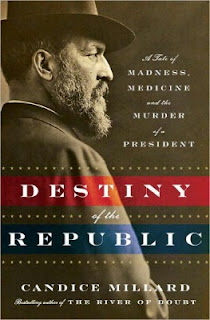 Funny, because the entire time I was reading this book, I kept thinking about how well it was written, how beautifully the various parts of the story were entwined, and how author Candice Millard (pictured) kept my attention even though she was conveying history, which can be very boring at the hands of the wrong person. Then when I started work on this review, I realized for the first time that Millard also wrote another of my favorite books, The River of Doubt: Theodore Roosevelt's Darkest Journey.
Funny, because the entire time I was reading this book, I kept thinking about how well it was written, how beautifully the various parts of the story were entwined, and how author Candice Millard (pictured) kept my attention even though she was conveying history, which can be very boring at the hands of the wrong person. Then when I started work on this review, I realized for the first time that Millard also wrote another of my favorite books, The River of Doubt: Theodore Roosevelt's Darkest Journey. Sunday, December 18, 2011
Destiny of the Republic: A Tale of Madness, Medicine and the Murder of a President by Candice Millard
Before reading Destiny of the Republic, all I really remembered about James A. Garfield was that he was one of the US Presidents, and that he was assassinated while in office. After reading Destiny of the Republic, I knew that Garfield was a man of extraordinary but not perfect character, a strong believer in the equality of Blacks, never really wanted to be President of the United States, and died not from his assassin’s gunshot, but rather from medical ineptitude.
 Funny, because the entire time I was reading this book, I kept thinking about how well it was written, how beautifully the various parts of the story were entwined, and how author Candice Millard (pictured) kept my attention even though she was conveying history, which can be very boring at the hands of the wrong person. Then when I started work on this review, I realized for the first time that Millard also wrote another of my favorite books, The River of Doubt: Theodore Roosevelt's Darkest Journey.
Funny, because the entire time I was reading this book, I kept thinking about how well it was written, how beautifully the various parts of the story were entwined, and how author Candice Millard (pictured) kept my attention even though she was conveying history, which can be very boring at the hands of the wrong person. Then when I started work on this review, I realized for the first time that Millard also wrote another of my favorite books, The River of Doubt: Theodore Roosevelt's Darkest Journey. Destiny of the Republic also gives us such an in-depth tour through the insanity of Charles Guiteau (pictured), Garfield’s assassin, that I actually felt visceral anger and sympathy for him. Although clearly insane, he was never properly cared for by society and thusly left to commit a senseless act that rocked a nation.
And then there was Dr. Doctor Bliss (no, that is not a typo nor redundant.) Dr. Bliss, whose first name was Doctor, swooped in at the train station just after Guiteau shot Garfield (pre-security for Presidents), and dictatorially and disastrously took command of Garfield’s medical care, seemingly for the fame it would bring him. So forceful was Bliss’s dominance over Garfield’s medical care that, although other doctors including Garfield’s family doctor protested Bliss’s treatment decisions, he continued to treat Garfield literally to death. CLICK ON READ MORE BELOW...
Side stories of interest were of Joseph Lister who had recently pioneered sterile surgery, which Dr. Bliss refused to practice, which lead to Garfield’s unnecessary death. Also Alexander Graham Bell, who had recently exhibited his telephone at 1876 Centennial Exposition in Pennsylvania, and his (at the time) unsuccessful attempts to perfect an x-ray type machine to locate the bullet in Garfield’s back.
If you have any interest in history at all, you’ll enjoy this engrossing and well-written account of Garfield’s brief and tragic presidency and death.
Subscribe to:
Post Comments (Atom)








Fascinating, thanks SueAnn.
ReplyDelete